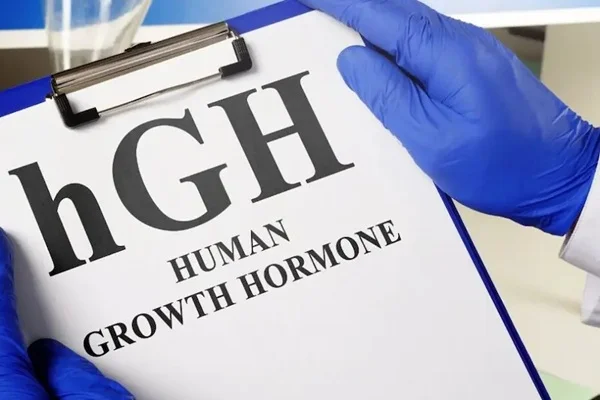
PROMO!
First order? Get 10% OFF with this code: 1storder
Written by

HGH191AA peptide contains the complete 191 amino acid sequence found in human growth hormone, which differs significantly from HGH Fragment 176-191 that includes only the final portion of the molecule.
Both peptides are designed exclusively for research purposes, though the HGH191AA peptide maintains the entire molecular structure of natural growth hormone, providing researchers with a more comprehensive tool for investigation.
Scientists study these peptides to identify their distinct biochemical properties, with the complete amino acid sequence in HGH191AA offering researchers comprehensive data for their investigations.
Understanding these fundamental differences becomes crucial when selecting the most suitable peptide for specific studies, particularly since research indicates that each peptide has unique characteristics that influence experimental outcomes.
Discover HGH191AA Peptide from Peptide Works, a peptide studied for its complete sequence, receptor binding, and broad metabolic effects.

The complete 191 amino acid structure makes HGH191AA peptide identical to natural growth hormone, enabling researchers to study this full sequence and understand the complete hormonal effects in laboratory settings.
Each amino acid position serves a specific function in molecular binding studies, while research demonstrates that the full chain activates multiple cellular pathways and maintains structural stability across different testing conditions.
This comprehensive activation stands in stark contrast to shorter fragments like HGH Frag, which miss crucial amino acids needed for complete receptor activation and consequently limit their effects to selective pathways, such as fat metabolism, rather than the broader spectrum of growth hormone activities.
Cellular pathways respond dramatically differently to various peptide structures, with HGH191AA peptide activating IGF-1 pathways in laboratory cell cultures while fragment versions trigger more selective fat metabolism pathways.
Scientists can track these pathway activations using specialized imaging and measurement techniques, revealing how complete amino acid chains stimulate multiple signaling cascades simultaneously.
In contrast, shorter peptides like HGH Frag demonstrate a much narrower focus, similar to how CJC peptides work through different GHRH receptor pathways.
These pathway differences provide researchers with critical information for choosing the right peptide for their specific studies, ensuring optimal experimental design and data collection.
Lipolysis breaks down stored triglycerides into glycerol and free fatty acids through specific enzymes, with HGH191AA peptide triggering hormone-sensitive lipase activation in adipocyte cells during testing.
This complex process begins when peptides bind to specific growth hormone receptors on fat cells, initiating a cascade of metabolic activity that researchers can monitor and measure.
While Fragment 176-191 focuses specifically on lipolytic pathways without affecting glucose metabolism or insulin sensitivity, the complete HGH191AA peptide causes broader metabolic changes that extend far beyond fat breakdown.
Although both peptides increase fatty acid release, they accomplish this through slightly different mechanisms that researchers can distinguish and compare in controlled laboratory environments.

Growth hormone receptors contain specific binding sites that match certain amino acid sequences, allowing the complete HGH191AA peptide to bind to the full receptor complex and trigger conformational changes that initiate intracellular signaling cascades.
This binding process requires two receptor molecules to form an active complex, which creates comprehensive cellular responses throughout the system.
Fragment 176-191, however, binds only to part of the receptor’s domain, creating targeted but limited responses due to its shorter sequence that enables faster binding but produces weaker overall receptor activation compared to the full molecule.
This fundamental difference in receptor interaction explains why HGH Frag produces focused fat-burning effects, while HGH191AA creates broader metabolic changes that affect multiple physiological systems.
Once bound to receptors, HGH191AA activates the JAK2-STAT5 pathway, leading to gene transcription changes that affect metabolism and cell growth, while simultaneously stimulating the MAPK/ERK pathway that promotes cellular proliferation and differentiation.
Fragment 176-191 takes a more targeted approach, mainly activating lipolytic portions of these cascades through PKA and HSL phosphorylation, which creates more focused cellular responses.
CJC peptides operate through an entirely different mechanism, activating cAMP-dependent pathways by binding to GHRH receptors, which then stimulates natural growth hormone release.
The activation patterns and duration differ significantly between these approaches HGH191AA produces sustained activation lasting several hours, while fragments create shorter, more focused responses that researchers can isolate and study.
HGH191AA peptide produces broad anabolic effects, including enhanced muscle development, increased protein synthesis, and accelerated tissue repair that researchers can measure across multiple biological systems.
In contrast, HGH Fragment 176-191 demonstrates high specificity to fat tissue, targeting fat breakdown and reducing lipid storage without affecting muscle mass or other growth-related processes.
These fundamental differences make peptide selection absolutely critical for research goals, as each provides distinct advantages depending on the specific biological pathways that investigators want to study and the outcomes they hope to measure.

IGF-1 serves as the main mediator of HGH191AA’s effects, creating a crucial biological pathway where HGH191AA administration stimulates the liver to produce IGF-1, which then travels to tissues and triggers muscle growth and repair.
Without adequate IGF-1 production, HGH191AA cannot reach its full anabolic potential, making this relationship essential for understanding the peptide’s complete mechanism of action.
HGH Fragment does not significantly increase IGF-1 levels, which naturally limits its effects to local fat metabolism and explains why it doesn’t produce the broader anabolic effects that characterize the complete peptide’s activity profile.
Explore HGH Frag from Peptide Works, a peptide studied for targeting fat metabolism through a specific amino acid sequence.
| Feature | HGH191AA Peptide | HGH Fragment 176-191 |
|---|---|---|
| Amino Acid Sequence | Complete 191 sequence | Final portion only (176–191) |
| Receptor Binding | Full receptor complex, broad activation | Partial receptor binding, targeted activation |
| Main Pathways | IGF-1, JAK2-STAT5, MAPK/ERK | Lipolytic (PKA, HSL) |
| Biological Effects | Muscle growth, protein synthesis, tissue repair, metabolic regulation | Fat breakdown, reduced lipid storage |
| IGF-1 Production | Strong stimulation | Minimal |
| Research Focus | Multi-tissue studies | Fat metabolism research |
The choice between these peptides depends entirely on research goals, with HGH191AA offering complete growth hormone effects that make it ideal for studies involving muscle growth, protein synthesis, and broad metabolic regulation.
HGH Fragment 176-191 focuses specifically on fat metabolism without the growth-promoting effects that might complicate results in targeted studies, providing researchers with cleaner experimental conditions.
Researchers seeking comprehensive multi-tissue responses typically choose HGH191AA for its broad biological impact, while fat-loss studies benefit significantly from HGH Fragment’s selectivity, which allows for more focused experimental data and precise research outcomes.
All products discussed are supplied for research purposes only and are not intended for human use.
[1] Habibullah MM, Mohan S, Syed NK, Makeen HA, Jamal QMS, Alothaid H, Bantun F, Alhazmi A, Hakamy A, Kaabi YA, Samlan G, Lohani M, Thangavel N, Al-Kasim MA. Human Growth Hormone Fragment 176-191 Peptide Enhances the Toxicity of Doxorubicin-Loaded Chitosan Nanoparticles Against MCF-7 Breast Cancer Cells. Drug Des Devel Ther. 2022 Jun 27;16:1963-1974.
[2] Sinha YN, Jacobsen BP. Human growth hormone (hGH)-(44-191), a reportedly diabetogenic fragment of hGH, circulates in human blood: measurement by radioimmunoassay. J Clin Endocrinol Metab. 1994 Jun;78(6):1411-8.
[3] Heffernan MA, Jiang WJ, Thorburn AW, Ng FM. Effects of oral administration of a synthetic fragment of human growth hormone on lipid metabolism. Am J Physiol Endocrinol Metab. 2000 Sep;279(3):E501-7.
[4] Anderson LJ, Tamayose JM, Garcia JM. Use of growth hormone, IGF-I, and insulin for anabolic purpose: Pharmacological basis, methods of detection, and adverse effects. Mol Cell Endocrinol. 2018 Mar 15;464:65-74.
ALL CONTENT AND PRODUCT INFORMATION AVAILABLE ON THIS WEBSITE IS FOR EDUCATIONAL PURPOSES ONLY.
DISCLAIMER: These products are intended solely as a research chemical only. This classification allows for their use only for research development and laboratory studies. The information available on our Peptide Works website: https://peptide-works.com/ is provided for educational purposes only. These products are not for human or animal use or consumption in any manner. Handling of these products should be limited to suitably qualified professionals. They are not to be classified as a drug, food, cosmetic, or medicinal product and must not be mislabelled or used as such.
Peptide Works
Related Articles

How effective could Orexin Addiction Therapy be?
Have you ever wondered why some people find it so hard to stop addictive habits, even when they truly want

Can NAD Therapy Improve Cognitive Performance?
NAD Therapy is gaining attention in research for its possible role in brain health. NAD+ (nicotinamide adenine dinucleotide) is a

Enhancing Energy with NAD+ Supplements
Energy is the driving force behind focus, movement, and recovery. When cells have less energy to work with, the body